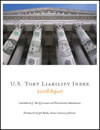North Carolina’s Business Court is a “model for the nation,” according to Directorship Magazine’s Annual Guide to State Litigation.

In addition to complimenting the Business Court, the Annual Guide gave North Carolina’s litigation climate a green light, indicating that the “state’s liability climate encourages growth and job creation.” It gave North Carolina a high national ranking, much higher than the State’s ranking in the U.S. Chamber of Commerce rankings issued earlier this year.
The State’s litigation climate ranking was sixth (behind Tennesse, Utah, Indiana, Ohio, and North Dakota), against twenty-first in the U.S. Chamber report.
Depending on your perspective, the litigation weather in North Carolina according to the Guide is partly cloudy or partly sunny. The Guide said that North Carolina
“has maintained a fair and predictable liability climate that leads to growth and job creation. It ranks among the three best states for monetary tort losses, improving from 7th in 2006. However, North Carolina’s product liability losses rank 36th, which indicates heightened litigation activity and a rise in jury verdicts. Further, the state’s plaintiffs’ bar is very active in the state legislature: a bill defeated last year extending the statute of repose from 6 to 15 years would have made North Carolina one of three states with the longest period for filing claims. There is a rule of law majority on the state Supreme Court and the state business court serves as a model for the nation. North Carolina, however, is a state to be watched because of aggressive trial bar legislative efforts.”
The Directorship Magazine rankings took the U.S. Chamber of Commerce rankings and evaluated them in conjunction with the U.S. Tort Liability Index prepared by the Pacific Research Institute, blending the two into its own ranking. North Carolina was ranked third in the Pacific Research Institute’s study, which evaluates a myriad of empirical evidence. The Institute’s complete spreadsheet, containing data for all 50 states, is here.
The North Carolina Business Court Is A “Model For the Nation”
Mack Sperling
North Carolina’s Business Court is a “model for the nation,” according to Directorship Magazine’s Annual Guide to State Litigation.
In addition to complimenting the Business Court, the Annual Guide gave North Carolina’s litigation climate a green light, indicating that the “state’s liability climate encourages growth and job creation.” It gave North Carolina a high national ranking, much higher than the State’s ranking in the U.S. Chamber of Commerce rankings issued earlier this year.
The State’s litigation climate ranking was sixth (behind Tennesse, Utah, Indiana, Ohio, and North Dakota), against twenty-first in the U.S. Chamber report.
Depending on your perspective, the litigation weather in North Carolina according to the Guide is partly cloudy or partly sunny. The Guide said that North Carolina
“has maintained a fair and predictable liability climate that leads to growth and job creation. It ranks among the three best states for monetary tort losses, improving from 7th in 2006. However, North Carolina’s product liability losses rank 36th, which indicates heightened litigation activity and a rise in jury verdicts. Further, the state’s plaintiffs’ bar is very active in the state legislature: a bill defeated last year extending the statute of repose from 6 to 15 years would have made North Carolina one of three states with the longest period for filing claims. There is a rule of law majority on the state Supreme Court and the state business court serves as a model for the nation. North Carolina, however, is a state to be watched because of aggressive trial bar legislative efforts.”
The Directorship Magazine rankings took the U.S. Chamber of Commerce rankings and evaluated them in conjunction with the U.S. Tort Liability Index prepared by the Pacific Research Institute, blending the two into its own ranking. North Carolina was ranked third in the Pacific Research Institute’s study, which evaluates a myriad of empirical evidence. The Institute’s complete spreadsheet, containing data for all 50 states, is here.
Nothing contained in this blog is to be construed as necessarily reflecting the views of the Pacific Research Institute or as an attempt to thwart or aid the passage of any legislation.